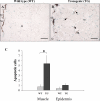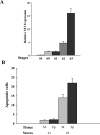Tissue-dependent induction of apoptosis by matrix metalloproteinase stromelysin-3 during amphibian metamorphosis
- PMID: 20301218
- PMCID: PMC3412310
- DOI: 10.1002/bdrc.20170
Tissue-dependent induction of apoptosis by matrix metalloproteinase stromelysin-3 during amphibian metamorphosis
Abstract
Matrix metalloproteinases (MMPs) are a superfamily of Zn(2+)-dependent proteases that are capable of cleaving the proteinaceous component of the extracellular matrix (ECM). The ECM is a critical medium for cell-cell interactions and can also directly signal cells through cell surface ECM receptors, such as integrins. In addition, many growth factors and signaling molecules are stored in the ECM. Thus, ECM remodeling and/or degradation by MMPs are expected to affect cell fate and behavior during many developmental and pathological processes. Numerous studies have shown that the expression of MMP mRNAs and proteins associates tightly with diverse developmental and pathological processes, such as tumor metastasis and mammary gland involution. In vivo evidence to support the roles of MMPs in these processes has been much harder to get. Here, we will review some of our studies on MMP11, or stromelysin-3, during the thyroid hormone-dependent amphibian metamorphosis, a process that resembles the so-called postembryonic development in mammals (from a few months before to several months after birth in humans when organ growth and maturation take place). Our investigations demonstrate that stromelysin-3 controls apoptosis in different tissues via at least two distinct mechanisms.
(c) 2010 Wiley-Liss, Inc.
Figures






Similar articles
-
Regulation of extracellular matrix remodeling and cell fate determination by matrix metalloproteinase stromelysin-3 during thyroid hormone-dependent post-embryonic development.Pharmacol Ther. 2007 Dec;116(3):391-400. doi: 10.1016/j.pharmthera.2007.07.005. Epub 2007 Aug 31. Pharmacol Ther. 2007. PMID: 17919732 Free PMC article. Review.
-
Matrix metalloproteinase stromelysin-3 in development and pathogenesis.Histol Histopathol. 2005 Jan;20(1):177-85. doi: 10.14670/HH-20.177. Histol Histopathol. 2005. PMID: 15578436 Review.
-
Differential regulation of three thyroid hormone-responsive matrix metalloproteinase genes implicates distinct functions during frog embryogenesis.FASEB J. 2000 Mar;14(3):503-10. doi: 10.1096/fasebj.14.3.503. FASEB J. 2000. PMID: 10698965
-
Overexpression of matrix metalloproteinases leads to lethality in transgenic Xenopus laevis: implications for tissue-dependent functions of matrix metalloproteinases during late embryonic development.Dev Dyn. 2001 May;221(1):37-47. doi: 10.1002/dvdy.1123. Dev Dyn. 2001. PMID: 11357192
-
Spatial and temporal regulation of collagenases-3, -4, and stromelysin -3 implicates distinct functions in apoptosis and tissue remodeling during frog metamorphosis.Cell Res. 1999 Jun;9(2):91-105. doi: 10.1038/sj.cr.7290009. Cell Res. 1999. PMID: 10418731
Cited by
-
Differential effects of 3,5-T2 and T3 on the gill regeneration and metamorphosis of the Ambystoma mexicanum (axolotl).Front Endocrinol (Lausanne). 2023 Jul 10;14:1208182. doi: 10.3389/fendo.2023.1208182. eCollection 2023. Front Endocrinol (Lausanne). 2023. PMID: 37492199 Free PMC article.
-
Thyroid hormone-induced cell-cell interactions are required for the development of adult intestinal stem cells.Cell Biosci. 2013 Apr 1;3(1):18. doi: 10.1186/2045-3701-3-18. Cell Biosci. 2013. PMID: 23547658 Free PMC article.
-
Integrative proteome and metabolome analyses reveal molecular basis of the tail resorption during the metamorphic climax of Nanorana pleskei.Front Cell Dev Biol. 2024 Aug 19;12:1431173. doi: 10.3389/fcell.2024.1431173. eCollection 2024. Front Cell Dev Biol. 2024. PMID: 39224435 Free PMC article.
-
Hydroxylated polychlorinated biphenyls may affect the thyroid hormone-induced brain development during metamorphosis of Xenopus laevis by disturbing the expression of matrix metalloproteinases.Mol Biol Rep. 2024 May 7;51(1):624. doi: 10.1007/s11033-024-09555-w. Mol Biol Rep. 2024. PMID: 38710963
-
Paralogues of Mmp11 and Timp4 Interact during the Development of the Myotendinous Junction in the Zebrafish Embryo.J Dev Biol. 2019 Dec 3;7(4):22. doi: 10.3390/jdb7040022. J Dev Biol. 2019. PMID: 31816958 Free PMC article.
References
-
- Ahmad A, Hanby A, Dublin E, Poulsom R, Smith P, Barnes D, Rubens R, Anglard P, Hart I. Stromelysin 3: an independent prognostic factor for relapse-free survival in node-positive breast cancer and demonstration of novel breast carcinoma cell expression. Am J Pathol. 1998;152(3):721–728. - PMC - PubMed
-
- Alexander CM, Hansell EJ, Behrendtsen O, Flannery ML, Kishnani NS, Hawkes SP, Werb Z. Expression and function of matrix metalloproteinases and their inhibitors at the maternal-embryonic boundary durng mouse embryo implantation. Development. 1996;122:1723–1736. - PubMed
-
- Alexander CM, Werb Z. Extracellular matrix degradation. In: Hay ED, editor. Cell Biology of Extracellular Matrix. 2nd ed. Plenum Press; New York: 1991. pp. 255–302.
-
- Amano T, Fu L, Marshak A, Kwak O, Shi YB. Spatio-temporal regulation and cleavage by matrix metalloproteinase stromelysin-3 implicate a role for laminin receptor in intestinal remodeling during Xenopus laevis metamorphosis. Dev Dyn. 2005a;234(1):190–200. - PubMed
-
- Amano T, Fu L, Sahu S, Markey M, Shi Y-B. Substrate specificity of Xenopus matrix metalloproteinase stromelysin-3. International Journal of Molecular Medicine. 2004;14:233–239. - PubMed
Publication types
MeSH terms
Substances
Grants and funding
LinkOut - more resources
Full Text Sources

